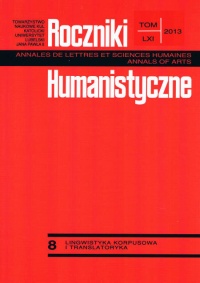„Llibre d’amic e amat” Rajmunda Lulla. Problem przekładu imion tytułowych postaci
Abstrakt
One of the most famous and widely read works of Raymond Lull (1235-1316) is the Llibre d’ amic e amat. This simple title, as it turns out, is not at all clear enough and causes difficulties in Polish translations. The name of the first character, which is human—amic, appears in Polish translations as a friend or a lover, and the name of the other, which is God—amat, appears as a lover or beloved. Which of the variants more adequately captures the meaning of the original? For the rational getting bottom of the problem it is necessary to analyse the Catalan term from the semantic point of view at first. At the same time there have to be taken into consideration that the term locates its etymological source in the culture of the Latin language. Whereas the Lull's work draws inspiration from the Bible, it is also necessary to examine the biblical context of different kinds of love and the specific terms that define them. Pragmatic analysis also allows us to capture the specificity of the relationship of people related with a specific kind of love. An interdisciplinary reflection on the names of the mystic work shows the non-randomness of the literary convention settled in the concrete realities of religious experience, with its specificity in the context of the culture of the source language as well as the target language. This study, beyond the very analysis of the problem, also gives the author translation proposal with Polish equivalents of the title characters’ names of the work.
« Llibre d’amic e amat » par Raymond Lull. Problème de la traduction des prénoms des personnages du titre
Une des œuvres des plus connues et lues de Rajmund Lull (1235-1316) est intitulée Llibre d’amic e amat. Ce titre paraît simple mais en réalité il n’est pas univoque et pose des problèmes aux traducteurs polonais. Le prénom du premier personnage qu’est l’homme – amic, est traduit comme przyjaciel, miłujący, ou encore kochanek; le prénom du deuxième qu’est Dieu – amat, est traduit comme ukochany ou umiłowany. Lequel de ces mots exprime-t-il le mieux le sens du texte original ? Pour bien saisir le problème, il est nécessaire de faire d’abord l’analyse sémantique du terme catalan et de son étymologie qui prend sa source dans la culture propre au latin. L’œuvre de Lull s’inspire de la Bible, il est donc nécessaire d’étudier le contexte biblique dans lequel nous trouvons différents types d’amour désignés par des termes appropriés. L’analyse pragmatique permet de définir la spécificité des relations entre les personnes liées entre elles par un type donné d’amour. Une réflexion interdisciplinaire sur les prénoms de cette œuvre mystique montre que la convention littéraire n’est pas le fruit du hasard mais qu’elle est située dans l’expérience religieuse concrète et qu’elle a sa propre spécificité aussi bien dans la culture de la langue du départ que dans celle d’arrivée. L’analyse linguistique et biblique est complétée par la proposition des équivalents polonais des prénoms des personnages dans le titre.
Bibliografia
Gorgoń Katarzyna, 2011, «Christianus Arabicus – Rajmund Lull jako pierwszy misjonarz wśród muzułmanów», [in:] W nurcie franciszkańskim, 18, 65-79.
Pardo Pastor Jordi, 2001, «Tradición misticoplatónica en el Llibre d’Amic e Amat de Ramon Lllull», [in:] Estudios Eclesiásticos, 76, 437-450.
Raurell Fredric, 2013, «Influsso di Origene sulla lettura medievale del Cantico dei Cantici», [in:] Laurentianum, 54, 3-19.
Ravasi Gianfranco, 2002, «Amore», [in:] Teologia, red. Giuseppe Barbaglio, Giampiero Bof, Severino Dianich, seria Dizionari San Paolo, Milano, Edizioni San Paolo, 13-36.
Sawicka Anna, 2003, Ramon Llull, poeta szalony z miłości, 5-42, [in:] Llull Ramon, Księga Przyjaciela i Umiłowanego. Brewiarz mistyczny, przekł. A. Sawicka, Kraków, Księgarnia Akademicka.
Vitiello Salvatore, 2013, «Eros e Agape. Il contributo di Benedetto XVI», [in:] Communio, 237, 81-88.
Wilk Mateusz, 2005, «Wpływ mistyki muzułmańskiej na Księgę Miłującego i Umiłowanego Ramona Llulla, [in:] Sacrum. Obraz i funkcja w społeczeństwie średniowiecznym, A. Pieniądz-Skrzypczak, J. Pysiak [red.], Warszawa, Wydawnictwo Uniwersytetu Warszawskiego, 177-189.
Wronecka Joanna, 2010, «Wstęp», [in:] Ibn Arabi, 2010, Traktat o miłości, przekł. J. Wronecka, Warszawa, Wydawnictwo Naukowe PWN, VII-LIII.
Copyright (c) 2013 Roczniki Humanistyczne

Utwór dostępny jest na licencji Creative Commons Uznanie autorstwa – Użycie niekomercyjne – Bez utworów zależnych 4.0 Międzynarodowe.





